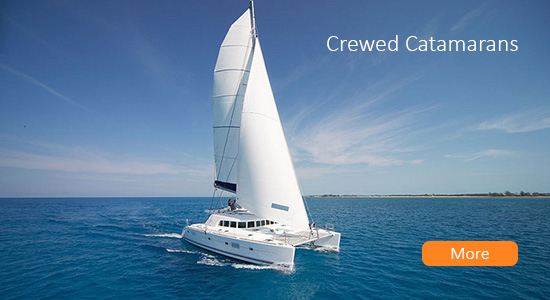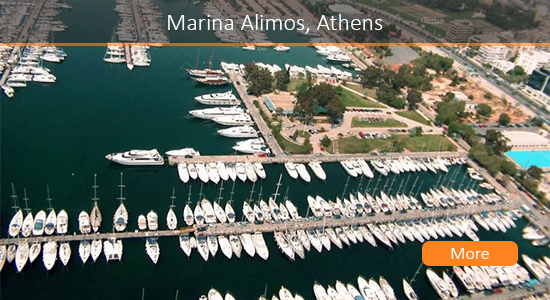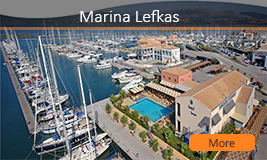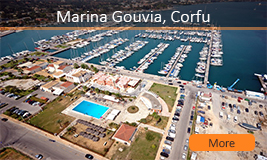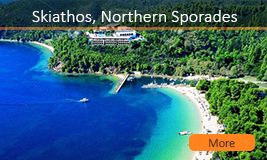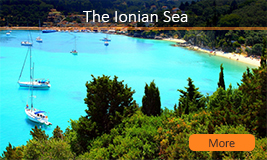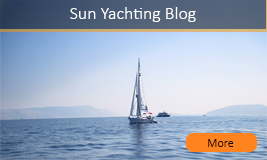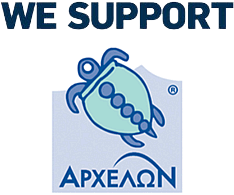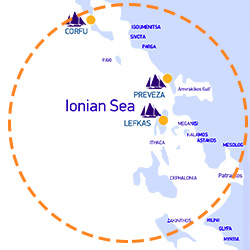SAILING ROUTES / THE IONIAN SEA
From the heel of Italy most yachts cross the Otranto Strait to Corfu (Kerkyra), which is located just 70 miles away. Corfu (Kerkyra) is the first of the seven Ionian Islands.
Traveling south from Corfu (Kerkyra) you will reach the islands of Paxi and Antipaxi, Lefkada (Lefkas), Ithaki, Kefalonia (Cephalonia), Zakynthos (Zante) and Kythira (Kythera).
To those of you who visualize a Greece of sun-baked rock dotted with dazzling whitewashed houses, the Ionian Islands comes as a wonderful surprise.
This is not the Greece of the popular travel brochure but a shaded green country, sheltering red tiled Latin houses an eccentric collection of Italian and French architecture and English tastes (in Corfu the locals play cricket and you can buy currant buns and ginger beer) fused together to create a land that is indisputably Greek.
Evergreen cypress, pine and elm trees, green fields, flowers even in height of summer, and everywhere the dark sheen of the olive fruit, are characteristics of the lower land while higher up the slopes are covered in pine trees.
If the wind blows in the right direction, you can smell the pungent herby aroma a mile out to sea. The green lushness of the islands contrast with the high craggy mountains of Albania and mainland Greece that are located on the eastern coast of the Ionian Sea.
This barren backdrop of the islands is just a taste of the geographical morphology to come. Between the isles there are protected waters where the wind seldom blows strongly and a multitude of lazy anchorages that are accessible only by yacht.
Sailing south past the islands of Lefkada (Lefkas), Ithaki and Kefalonia (Cephalonia), you reach Zakynthos (Zante), whose landscape resembles the rolling English countryside, and meet the rocky slopes of the Peloponnese.
Experience this sailing trip from a choice of bareboats, catamarans, motor yachts, sailing yachts and all varieties of vessels for your unfogetable sailing in Greece experience.
Get in touch for offers and pricing on all our sailing yachts
Base Marina Gouvia Corfu
- Corfu (Kerkyra) - Paxoi 32 n.m.
- Paxoi - Fiskardo 48 n.m.
- Fiskardo - Ithaki 15 n.m.
- Ithaki - Meganisi 20 n.m.
- Meganisi - Parga 42 n.m.
- Parga - Syvota 10 n.m.
- Syvota - Corfu (Kerkyra) 28 n.m.
Base Marina Preveza or Lefkas
- Lefkas / Preveza - Syvota 35 n.m.
- Syvota - Corfu (Kerkyra) 28 n.m.
- Corfu (Kerkyra) - Paxoi 32 n.m.
- Paxoi - Fiskardo 48 n.m.
- Fiskardo - Meganisi 18 n.m.
- Meganisi - Lefkada (Lefkas) 12 n.m.
- Lefkada (Lefkas) - Preveza 10 n.m.
Base Marina Gouvia Corfu
- Corfu (Kerkyra) - Paxoi32 n.m.
- Paxoi - Fiskardo 48 n.m.
- Fiskardo - Ithaki 15 n.m.
- Ithaki - Zakynthos (Zante) 38 n.m.
- Zakynthos (Zante) - Ag. Efimia (Kefallonia) 35 n.m.
- Ag. Efimia (Kefallonia) - Astakos 30 n.m.
- Astakos - Kalamos 12 n.m.
- Kalamos - Meganisi 10 n.m.
- Meganisi - Lefkada (Lefkas) 12 n.m.
- Lefkada (Lefkas) - Parga 32 n.m.
- Parga - Syvota 10 n.m.
- Syvota - Corfu (Kerkyra) 28 n.m.
Base Marina Preveza or Lefkas
- Lefkas / Preveza - Syvota 35 n.m.
- Syvota - Corfu (Kerkyra) 28 n.m.
- Corfu (Kerkyra) - Paxoi 32 n.m.
- Paxoi - Fiskardo 48 n.m.
- Fiskardo - Ithaki 15 n.m.
- Ithaki - Zakynthos (Zante) 38 n.m.
- Zakynthos (Zante) - Ag. Efimia (Kefallonia) 35 n.m.
- Ag. Efimia (Kefallonia) - Astakos 30 n.m.
- Astakos - Kalamos 12 n.m.
- Kalamos - Meganisi 10 n.m.
- Meganisi - Lefkada (Lefkas) 12 n.m.
- Lefkada (Lefkas) - Preveza 10 n.m
More info about the Ionian Sea
The relatively tideless waters of the Mediterranean, a magnetic variation of just over 2°(2°05' e1990(4'E)) enhances your sailing but there are hazards, while navigating in the area.
Heat haze in the summer can reduce visibility to a mile or two but rain cleanses the air and improves visibility. In the morning, especially around North Corfu (Kerkyra) and the Corfu (Kerkyra) Channel, there may be dense fog which reduces visibility to ½ mile or less.
Gradually the fog is burned off by the sun and by afternoon all should be clear. The Ionian has only a few rocks you should be aware of. Due to the clarity of the water in the Mediterranean, rocks and shallows can easily be spotted.
Deep blue water » good
Deep green water » getting shallow
Lighter green water » beware
Brown water » species of molluscs can be identified.
Beware of fishing nets and avoid getting them wrapped around the propeller of your boat. Navigation at night while sailing on uncommon routes should be avoided unless you are familiar with the area. From June to September, wind blows into the Ionian Sea from NW to WNW. The wind starts around noon and blows at a force of 3 to 6 Beaufort (10 to 25 knots) and dies down at sunset. There may be strong gusts on the leeward side due to the high land (e.g. Eastern side of Ithaki and Zakynthos (Zante).
From July to August, winds are at their strongest. The presence of clouds on the summit warns you that winds are strong. In the evening the "Katabatic" wind may blow off the high mainland mountains, usually from the N.E. It can blow up to a wind force of 6 Beaufort (25 knots) and die down after 2/3 hours. A strong southern wind may turn northern and increase in strength. Care, therefore, is needed when sheltering from the southern wind. A "Scirocco" may also blow from the south, usually in the spring, bringing with it humid heat and the red sands of the Sahara.
Source: Greek Water Pilot

